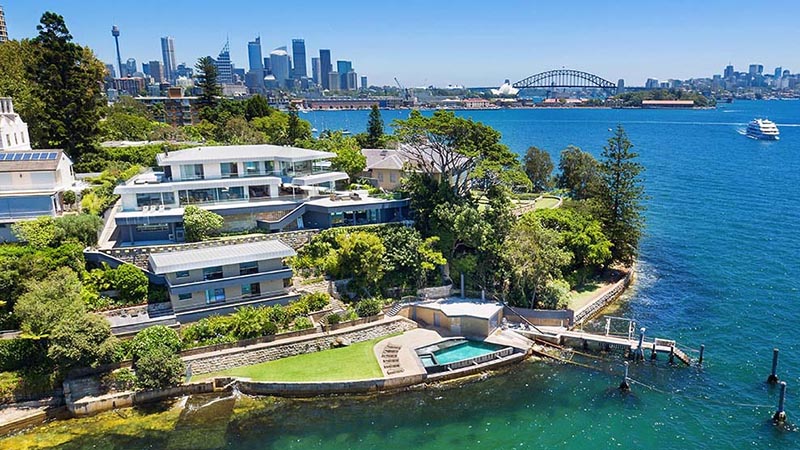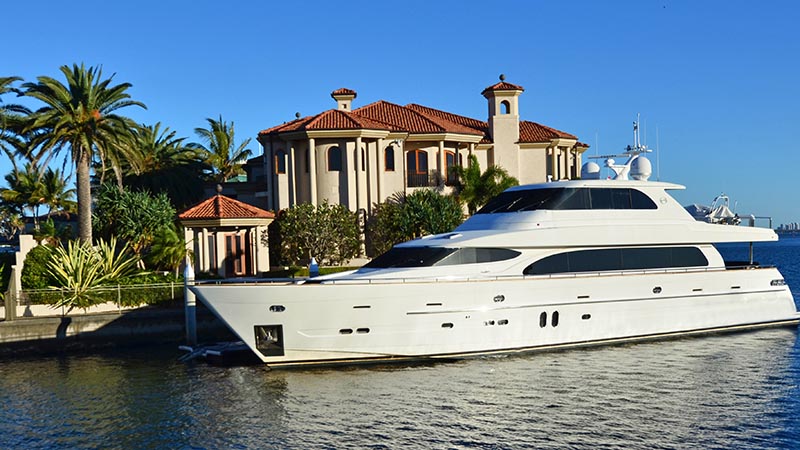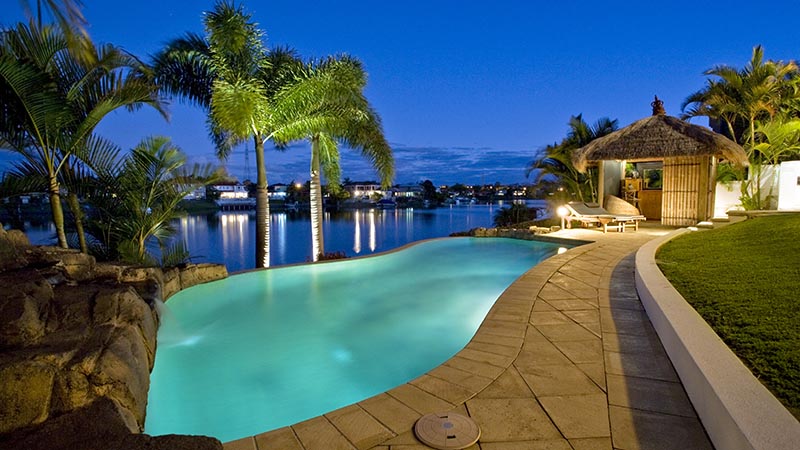Gold Coast among world's elite but Australia's prestige property markets slipping
The Gold Coast has come in at number five on a list that tracks the price growth of luxury property markets around the world, but signs are emerging that Australia's prime property market is now retreating.
While the bottom 95 per cent of the Australian property market struggles, the most expensive five per cent have delivered annual capital growth to rival the prestige markets around the world.
The majority of the most desirable and expensive properties around the world, generally defined as the top 5 per cent of each market by value, are still delivering price growth against a more general trend of falling property prices.
Of 45 countries assessed by the Knight Frank Prime Global Cities Index, 26 managed to deliver price growth in the three months to September 30 (Q3), with the Gold Coast ranking fifth in the world based on annual results.
THE KNIGHT FRANK PRIME GLOBAL CITIES INDEX Q3 2022
Ranked by annual % change
| CITY | WORLD REGION | 12-MONTH % CHANGE (Q3 2021-Q3 2022) |
6-MONTH % CHANGE (Q1 2022-Q3 2022) |
3-MONTH % CHANGE (Q2 2022-Q3 2022) |
|
|---|---|---|---|---|---|
| 1 | Dubai | Middle East | 88.80% | 49.90% | 29.30% |
| 2 | Miami1,3 | North America | 30.80% | 15.20% | 3.10% |
| 3 | Tokyo2 | Asia | 17.00% | 5.70% | 10.60% |
| 4 | Los Angeles1,3 | North America | 13.60% | 2.80% | -4.10% |
| 5 | Gold Coast | Australasia | 11.30% | 0.10% | -1.60% |
| 6 | Zurich | Europe | 10.70% | 6.10% | 2.80% |
| 7 | Edinburgh | Europe | 9.90% | 5.30% | 0.90% |
| 8 | Berlin | Europe | 9.40% | 4.30% | -0.90% |
| 9 | Seoul | Asia | 8.90% | 0.60% | -4.10% |
| 10 | Taipei | Asia | 8.60% | 3.30% | 1.70% |
| 11 | Dublin | Europe | 8.60% | 3.80% | 1.60% |
| 12 | Paris | Europe | 7.60% | 2.60% | 1.20% |
| 13 | Melbourne | Australasia | 6.70% | 0.40% | 0.70% |
| 14 | Lisbon | Europe | 6.10% | 2.40% | 1.00% |
| 15 | Singapore | Asia | 6.00% | 3.90% | 2.30% |
| 16 | Madrid | Europe | 5.60% | 3.10% | 1.60% |
| 17 | San Francisco1,3 | North America | 5.50% | -2.40% | -10.00% |
| 18 | Sydney | Australasia | 5.40% | -2.50% | -1.90% |
| 19 | New York | North America | 5.20% | 2.10% | 0.00% |
| 20 | Brisbane | Australasia | 5.20% | -2.40% | -2.40% |
| 21 | Auckland | Australasia | 4.90% | -1.50% | 8.30% |
| 22 | Mumbai | Asia | 4.80% | 3.50% | 2.10% |
| 23 | Shenzhen | Asia | 4.50% | -2.60% | -4.80% |
| 24 | Toronto | North America | 4.10% | -10.30% | -9.00% |
| 25 | Beijing | Asia | 3.90% | 0.40% | -0.90% |
| 26 | Perth | Australasia | 3.40% | -0.30% | -0.40% |
| 27 | Bengaluru | Asia | 3.30% | 1.90% | 1.50% |
| 28 | Geneva | Europe | 3.20% | 1.50% | 0.80% |
| 29 | Nairobi | Africa | 2.90% | 0.40% | 0.50% |
| 30 | Bucharest | Europe | 2.80% | 0.60% | 0.40% |
1 Based on top-tier of mainstream market in metro area. 2 Based on all contracts above Yen100m. 3 Provisional
*Notes: Data for New York relates to Manhattan; Data for Los Angeles, Miami and San Francisco is to August 2022. Data for Taipei and Monaco is to Q2 2022.
Source: All data comes from Knight Frank's global network with the exception of Tokyo (Ken Corporation); New York (StreetEasy); Los Angeles, Miami and San Francisco (S&P CoreLogic Case-Shiller); Berlin and Frankfurt (ZIEGERT Research/ ImmobilienScout 24); Stockholm (Svensk Maklarstatistik); Toronto (Real Estate Board of Toronto); Vancouver (Vancouver Real Estate Board); Zurich and Geneva (Wüest Partner).
Cooling national market
Although five Australian cities made the index’s top 30, all but one saw prices ease backwards in the past quarter.
The Gold Coast prime property market was up 11.3 per cent for the year but slipped 1.6 per cent in Q3, while 18th ranked Sydney fell 0.4 per cent, Brisbane placed 20th and retreated 2.4 per cent, and Perth (26th) was 0.4 per cent lower for the quarter.
Only Melbourne, ranked 13th, delivered capital gains in Q3, with prices up a further 0.7 per cent for an annual growth rate of 6.7 per cent.
Australia’s prime properties are slipping against the international trends.
The global index recorded average annual growth of 7.5 per cent in Q3 2022, down from a peak of 10 per cent in Q1 2022.
At 7.5 per cent, annual growth still sits above the index’s average five-year growth rate of 4.4 per cent, and the number of cities registering year-on-year price falls has only shifted from six last quarter to seven this quarter.
But dig deeper and the quarterly data reveals a marked slowdown. Of the 45 cities tracked, 19 saw prime prices decline between June and September 2022, up from seven in Q1 2022.
On an annual basis, 84 per cent of cities recorded price growth for prime properties on an annual basis.
Australia’s richest still buying
National property markets are declining relatively rapidly, but the upper echelons of the Australian property market continue to deliver strong gains in a highly competitive buyers’ market.
While Australia’s richest buyers can often contend with interest rate rises and are largely immune to the inflation that affects the costs of food and fuel, the pace of the RBA’s rate hike cycle is having some dampening effects on the luxury property market.
According to Sotheby’s International Realty, luxury home buyers still have mortgages in order to maximise leverage. Astute buyers use this as a negotiation tactic when discussing an offer price, even though they have the means to pay cash.
The stock market has seen sharp declines as the cost of borrowing has gone up. Luxury home buyers often rely on their portfolios to show strength in their offers, their liquidity, and their ability to purchase. In combination with higher rates, this is impacting purchasing power and causing the potential-buyer pool to shrink.
Michelle Ciesielski, Knight Frank Head of Residential Research, said Australia’s collective prime residential price growth was 6 per cent over the year to September 2022, although fell 1.2 per cent in the third quarter after 9.1 per cent annual growth recorded a year ago.
“In saying that, the number of prestige homes listed for sale remains relatively low across the major Australian markets and the number of days listed for sale has continued to fall from 90 days at the end of 2021, to 68 days half-way through 2022.
“However, we have seen the rate of change for prestige sales volume slow down collectively across Australia, though it was still 9.8 per cent higher in the second quarter of 2022 and increased 27.1 per cent over the year to this time.
“As a result, we may start to see the number of days on market increase over the coming year with price growth to follow.”
Resilient labour markets, a lack of supply and well capitalised lenders are expected to support prime prices in most markets, including Australia, into 2023.
In an earlier Knight Frank analysis, Australian cities took three of the top five slots in the 2022 International Waterfront Index, with Sydney leading the rankings and Gold Coast and Perth in the top echelon.

























